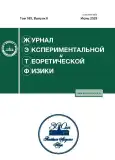Generation of Electric Fields in the Troposphere
- Авторлар: Smirnov B.M1
-
Мекемелер:
- Joint Institute for High Temperatures
- Шығарылым: Том 163, № 6 (2023)
- Беттер: 873-880
- Бөлім: Articles
- URL: https://journals.rcsi.science/0044-4510/article/view/145425
- DOI: https://doi.org/10.31857/S0044451023060135
- EDN: https://elibrary.ru/DHWCYY
- ID: 145425
Дәйексөз келтіру
Толық мәтін
Аннотация
A nonuniform dusty plasma, micrometer-size particles or microdroplets of which are located in a dense gas or in atmospheric air, is excited by an energy pulse leading to the weak ionization of the gas. As a result, the particles charge through the attachment of gaseous ions to them. The stability of dusty plasma is determined by the low mobility of charged microparticles. The conditions under which the separation of negative and positive charges occurs in a dusty plasma with the creation the electric field are considered. The criteria are presented for the generation of atmospheric electricity in a dense cloud as a result of the gravitational falling of charged water microdroplets in the atmosphere, the weak ionization of which occurs under the action of cosmic rays. It is shown that this is possible only under a nonuniform space distribution of water microdroplets in the cloud. The peculiarities of a dusty plasma are considered. This plasma exists in Saturn’s rings and in the flow of coal combustion products, as well as in the dusty atmosphere of a coal mine.
Авторлар туралы
B. Smirnov
Joint Institute for High Temperatures
Хат алмасуға жауапты Автор.
Email: bmsmirnov@gmail.com
125412, Moscow, Russia
Әдебиет тізімі
- https://solarsystem.nasa.gov/planets/saturn/in-depth
- P. Thakur, Advanced Mine Ventilation Respirable Coal Dust, Combustible Gas and Mine Fire Control, Amsterdam, Elsevier (2019).
- https://www.theatlantic.com/photo/2011/06/chiles-puyehue-volcano-erupts/100081
- B. J. Mason, The Physics of Clouds, Claredon Press, Oxford (1971).
- J. Warner, Tellus 7, 450 (1955).
- W. R. Leaitch and G. A. Isaak, Atmosp. Environ. 25, 601(1991)
- http://en.wikipedia.org/wiki/Liquid-water-content
- J. Bricard, in: Problems of Atmospheric and Space Electricity, ed. by C. C. Coronity, Amsterdam, Elsevier (1965), p. 82.
- U.S. Standard Atmosphere, U. S. Government Printing O ce, Washington (1976).
- M. V. Smolukhowski, Zs. Phys. 17, 585 (1916).
- Б. М. Смирнов, УФН 170, 495 (2000)
- B. M. Smirnov, Phys. Usp. 43, 453 (2000).
- Б. М. Смирнов, УФН 184, 1177 (2014)
- B. M. Smirnov, Phys. Usp. 57, 1041 (2014).
- N. Liu and V. P. Pasko, J.Geophys. Res. 109, A04301 (2004).
- V. P. Krainov, Qualitative Methods in Physical Kinetics and Hydrodynamics, American Inst. of Physics, New York (1992).
- J. R. Dwyer and M. Uman, Phys. Rep. 534, 147 (2014).
- H. Isra¨el, Atmospheric Electricity, Keter Press Binding, Jerusalem (1973).
- R. P. Feynman, R.B. Leighton, and M. Sands, The Feynman Lectures of Physics, Addison-Wesley, Reading (1964), Vol. 2.
- B. M. Smirnov, Global Atmospheric Phenomena Involving Water, Springer Atmospheric Series, Switzerland (2022).
- D. A. Gurnett, P. Zarka, R. Manning et al., Nature 409, 313(2001).
- H. J. Christian, R. J. Blakeslee, D. J. Boccippio et al., J. Geophys. Res. 108, 4005 (2003).
- http://en.wikipedia.org/wiki/Distribution-of-lightning
- M. A. Uman, Lightning, McGrow Hill, New York (1969).
Қосымша файлдар









